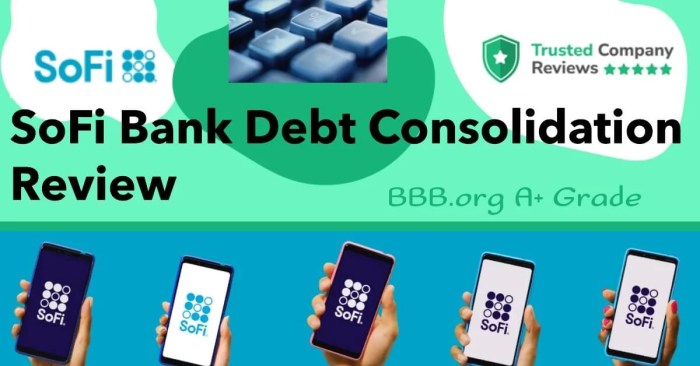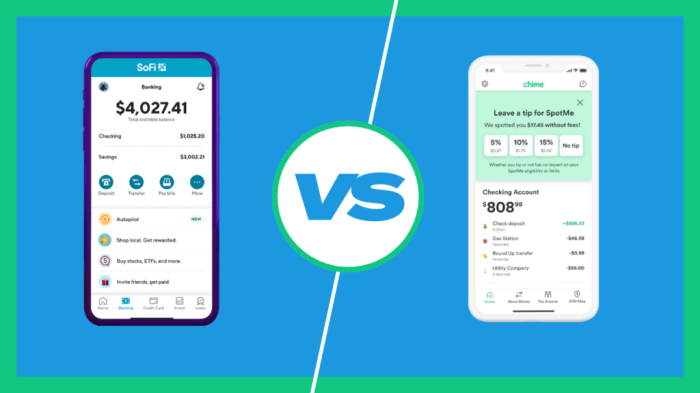Cit bank vs sofi – Citi Bank vs SoFi: Choosing the right bank can feel like navigating a minefield of fees, features, and fine print. This comprehensive comparison dives deep into the offerings of these two prominent financial institutions, examining everything from checking and savings accounts to investment options and customer service. We’ll dissect their strengths and weaknesses, helping you decide which bank best aligns with your financial needs and lifestyle.
From interest rates and account fees to the user-friendliness of their mobile apps and the robustness of their security measures, we leave no stone unturned. We’ll compare their credit card offerings, investment platforms, and customer support channels, providing a clear and concise picture to aid your decision-making process. Get ready to arm yourself with the knowledge you need to make the best choice for your money.
Citibank vs. SoFi: A Comparative Analysis: Cit Bank Vs Sofi
Choosing the right financial institution is a pivotal decision, impacting your financial well-being and overall experience. This comparison delves into the offerings of Citibank and SoFi, two prominent players in the financial landscape, to help you navigate this important choice. We’ll examine their account types, fees, customer service, security measures, and overall user experience, providing a comprehensive overview to empower your decision-making process.
Account Types and Features, Cit bank vs sofi
Understanding the diverse account options offered by Citibank and SoFi is crucial for aligning your financial needs with the right institution. Both banks provide a range of checking, savings, investment, and credit card products, each with its own set of features and benefits. Let’s examine these offerings in detail.
The choice between Cit Bank and SoFi often hinges on individual needs, a journey of self-discovery in the financial realm. Understanding Cit Bank’s broader context, however, requires exploring its relationships with other institutions, such as by comparing it to OneWest Bank; for a deeper dive into this connection, explore the insightful analysis at onewest bank cit bank.
Returning to Cit Bank versus SoFi, remember that the path to financial enlightenment is paved with informed decisions.
| Feature | Citibank | SoFi | Notes |
|---|---|---|---|
| Checking Account Options | Various checking accounts with varying features and fees, including options for students and those with high balances. | Offers a single checking account with features like no monthly fees and ATM rebates. | Citibank offers more diverse options, while SoFi prioritizes simplicity. |
A closer look at savings accounts reveals further distinctions:
- Interest Rates: Citibank’s savings account interest rates may vary depending on the account type and balance, while SoFi typically offers a competitive, market-based interest rate on its savings account.
- Minimum Balance Requirements: Citibank may impose minimum balance requirements for certain savings accounts to earn interest, whereas SoFi generally doesn’t have minimum balance requirements for its savings account.
| Investment Type | Citibank Details | SoFi Details | Key Differences |
|---|---|---|---|
| Brokerage Services | Offers a full-service brokerage with access to a wide range of investment products, including stocks, bonds, and mutual funds. | Provides access to a brokerage platform with a focus on ease of use and a streamlined investment experience. | Citibank offers a more comprehensive range of investment options, while SoFi prioritizes user-friendliness. |
Credit card offerings also differ significantly:
- Rewards Programs: Citibank offers a variety of credit cards with different rewards programs, such as cashback, travel points, or airline miles. SoFi’s credit card offerings may focus on a simpler rewards structure, potentially emphasizing cashback.
- APRs (Annual Percentage Rates): APRs vary considerably depending on the card and the applicant’s creditworthiness for both Citibank and SoFi. It’s essential to compare specific card offers.
- Fees: Both banks may charge annual fees for certain premium credit cards, and late payment fees are common to both.
Fees and Charges
A transparent understanding of fees is crucial for effective financial planning. Let’s analyze the fee structures of Citibank and SoFi across various account types.
| Fee Type | Citibank | SoFi |
|---|---|---|
| Checking Account Fees | May include monthly maintenance fees, overdraft fees, and other charges depending on the specific account type. | Generally does not charge monthly maintenance fees for its checking account, but overdraft fees may apply. |
Overdraft protection policies and associated fees are another important consideration:
- Citibank: Offers overdraft protection, but charges fees for each overdraft transaction. Specifics vary by account type.
- SoFi: May offer overdraft protection, but the specifics regarding fees should be confirmed directly with the institution.
International transaction fees also play a role in choosing the right bank:
- Citibank: Charges foreign transaction fees on international purchases made with their credit cards, the percentage varying by card.
- SoFi: May or may not charge foreign transaction fees, depending on the specific credit card; check the terms and conditions of the card.
Monthly maintenance fees are another factor to consider:
- Citibank: Certain checking and savings accounts may have monthly maintenance fees unless minimum balance requirements are met.
- SoFi: Generally waives monthly maintenance fees for its core checking and savings accounts.
Customer Service and Accessibility
Exceptional customer service and accessible platforms are essential for a positive banking experience. Let’s compare Citibank and SoFi in these areas.
Customer service channels differ significantly:
- Citibank: Offers phone support, online chat, and a vast network of physical branches.
- SoFi: Primarily relies on online and phone support, with limited or no physical branches.
Mobile banking app features and user experience are key differentiators:
- Citibank: Offers a mobile banking app with features such as account management, bill pay, and mobile check deposit. User experience varies by user.
- SoFi: Features a user-friendly mobile app with a streamlined interface and comprehensive features for managing accounts and investments.
Website and app accessibility for users with disabilities is a critical aspect:
- Citibank: Strives for website and app accessibility, adhering to ADA guidelines to varying degrees across platforms.
- SoFi: Generally maintains a user-friendly design, aiming for accessibility, but specifics should be checked on their website.
| Process Step | Citibank | SoFi |
|---|---|---|
| Initial Complaint Filing | Typically through phone, mail, or online channels. | Primarily through online channels or phone. |
Security and Safety

Source: slickdeals.net
Protecting customer data and preventing fraud are paramount concerns. Let’s evaluate the security measures implemented by Citibank and SoFi.
Security measures employed by both institutions include:
- Citibank: Employs encryption, multi-factor authentication, and fraud monitoring systems.
- SoFi: Utilizes robust security protocols, including encryption, two-factor authentication, and real-time fraud detection.
Fraud prevention tools available to customers:
- Citibank: Provides fraud alerts, account monitoring tools, and resources to report suspicious activity.
- SoFi: Offers similar fraud prevention tools, including alerts and account monitoring features.
Insurance coverage in case of data breaches or unauthorized access:
- Citibank: Offers varying levels of insurance coverage, the specifics of which should be confirmed directly with the institution.
- SoFi: Details on insurance coverage should be verified on their website or by contacting customer service.
Authentication methods used to verify customer identity:
- Citibank: Employs a combination of methods, including passwords, security questions, and potentially multi-factor authentication.
- SoFi: Typically uses passwords and multi-factor authentication for enhanced security.
Overall User Experience

Source: trustedcompanyreviews.com
The overall user experience encompasses ease of use, responsiveness, and overall satisfaction. Let’s compare Citibank and SoFi in these aspects.
A comparison of the overall user experience:
- Citibank: User experience can vary depending on the specific product and service used. Some users find the platform comprehensive but potentially complex.
- SoFi: Generally praised for its user-friendly interface and streamlined processes. The experience is often described as intuitive and efficient.
Onboarding processes for new customers:
- Citibank: The onboarding process may involve multiple steps and documentation.
- SoFi: Often described as having a simpler and faster onboarding process.
| Feature | Citibank Description | SoFi Description | Comparison |
|---|---|---|---|
| Account Management Interface | Can be detailed and feature-rich, potentially overwhelming for some users. | Typically streamlined and user-friendly, prioritizing ease of navigation. | SoFi prioritizes simplicity, while Citibank offers more comprehensive features. |
Online and mobile platform comparison:
- Citibank: Offers comprehensive online and mobile platforms, but the user experience may vary depending on the specific service used.
- SoFi: Known for its intuitive and user-friendly online and mobile platforms, emphasizing ease of navigation and access to key features.
Final Thoughts

Source: creditmashup.com
Ultimately, the “winner” in the Citi Bank vs. SoFi showdown depends entirely on your individual priorities. Citi Bank offers a more traditional banking experience with a vast branch network and established history. SoFi, on the other hand, boasts a sleek, modern approach with a focus on technology and innovative financial products. By carefully weighing the pros and cons Artikeld in this comparison, you can confidently select the bank that best caters to your specific financial goals and preferences.
Remember to always read the fine print and consider your long-term financial strategy.